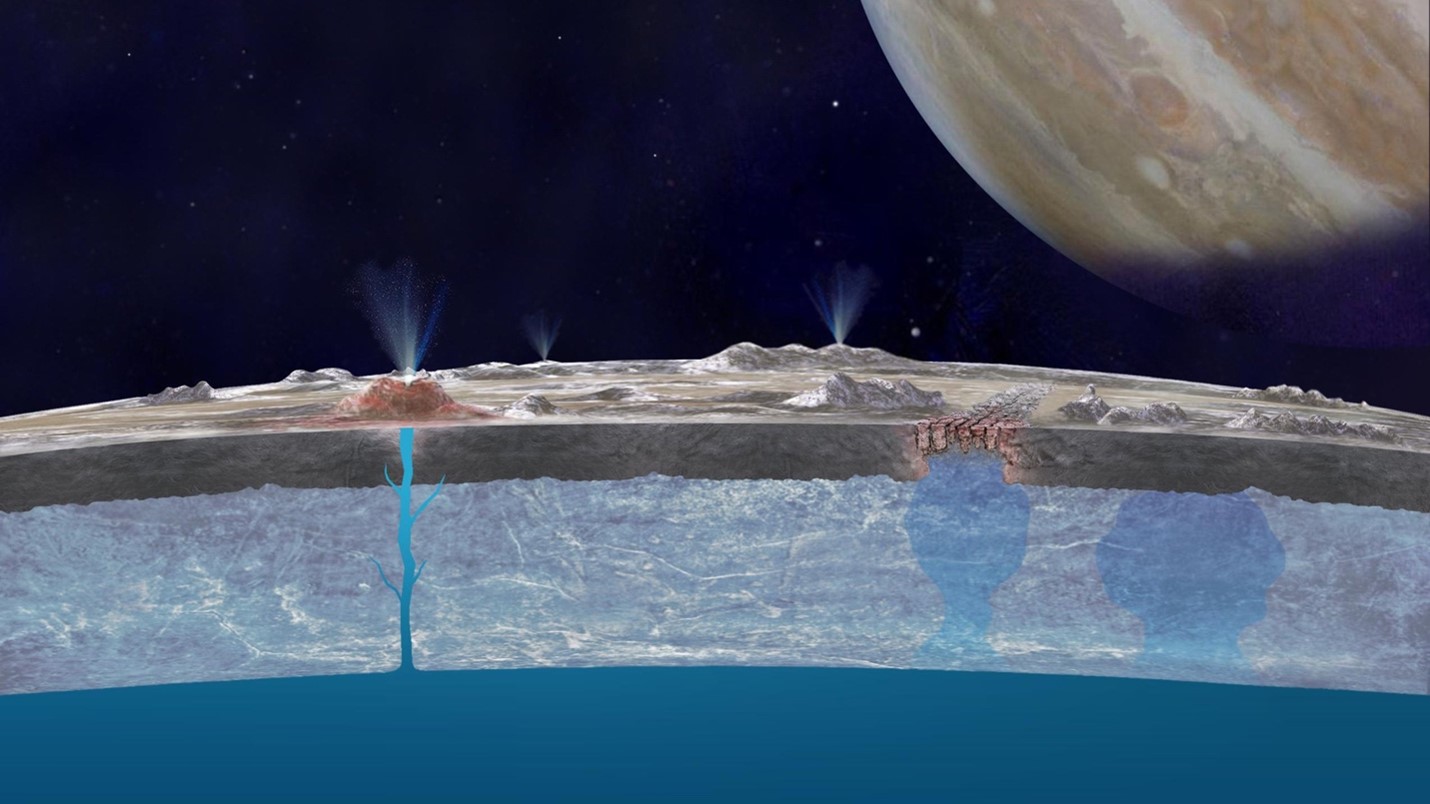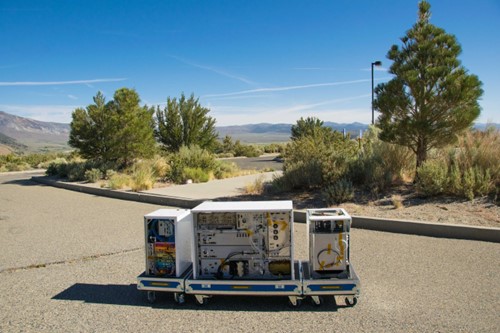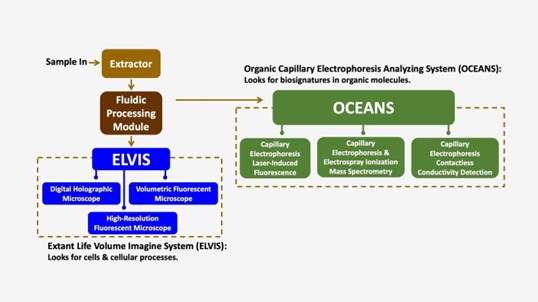by Rida Fatima

(Figure 1: Demonstration of the Icy under world of Enceladus showing the plumes emerging from beneath and going out in space. Credits: NASA/JPL (jpl.nasa.gov))
A team at the Lab has developed new innovative technologies that could be utilized by future space operations to analyze liquid samples from ocean worlds of Enceladus and Europa in search of alien life. Carl Sagan said, “Somewhere something incredible is waiting to be known”, enlightening a spark of curiosity to explore the unknown mysteries and riddles of the ever-expanding universe. One of the biggest questions of space exploration and search is “Are we alone in the Universe?” or do we have other interstellar or intergalactic companions living somewhere far away in the cosmos? NASA is playing an active role in this search and constantly developing innovative technologies for space investigations.
However, looking for signs of life in a frosty sea millions of miles away presents enormous challenges. The scientific equipment needed for this purpose must be intricately complex while also being resistant to intense radiation and cryogenic temperatures. Furthermore, the instruments must be capable of performing a variety of independent, complementary measurements that, when combined, may further yield scientifically rational proof of life (NASA, Europa Ocean Moon , 2022)
Ocean Worlds Life Surveyor (OWLS)
A device containing 8 instruments has been developed by NASA scientists that can detect life in watery geysers emerging from the icy moons such as Enceladus and possibly Europa. Saturn’s moon Enceladus and Jupiter’s moon Europa have always intrigued scientists as the prime location for the detection of life in the solar system. Due to thick ice, getting into these frosty ocean worlds is a difficult challenge. The Cassini spacecraft in 2006, discovered plumes of water vapor gushing from Enceladus. Likewise, the Hubble Space Telescope discovered intriguing evidence of geysers arising from Europa as well. A spacecraft upgraded with NASA’s new Ocean Worlds Life Surveyor (OWLS) device could now collect water samples while flying through the plumes. It will look for any microbial cells or bacterial sample evidence that the geysers may have ejected into space.

(Figure 2: OWLS by NASA’s JPL incorporates powerful chemical-analysis instruments that look for life’s building blocks with microscopes that search for cells. This OWLS version would be miniaturized and customized for future missions. Credit: NASA/JPL-Caltech)
What Is So Unique About OWLS?
Cassini flyby across the plumes was indeed a significant approach, however, the spacecraft did not have this instrument installed in it. Therefore, it was not able to give us a clear picture of possibility of life residing in Enceladus. Due to the large distances between Earth and Jupiter and Saturn, frequency range for data transmission is limited. As a result, OWLS must collect massive amounts of data, independently analyze it in the hopes of discovering life. Then it will send only the relevant information back to Earth (Cooper, 2022)
OWLS is a complete package of 8 experiments capable of determining whether or not life exists in the specimens that it collects. Experiments with owls in California’s highly saline Mono Lake, which scientists believe is comparable to the salty sea waters of Europa and Enceladus’ oceans, successfully “discovered” life. OWLS is now prepared to confront the icy moons after some restructuring. The microscope system of OWLS could image cells as it is a group of various microscopes attached. It was created in collaboration with researchers at Portland State University in Oregon. A digital holographic microscope (DHM) that identifies cells and motion throughout the volume of a sample is combined with two fluorescent imagers, using dyes to analyze chemical content and cellular structures.
ELVIS and OCEANS
The Extant Life Volumetric Imaging System (ELVIS) is the microscope subsystem. It is unique in that it has no moving parts and it also employs machine-learning algorithms to detect objects illuminated by fluorescent molecules, regardless of whether naturally produced in living organisms or added dyes bound to cell parts (JPL, 2022).

(Figure 3: ELVIS receives the liquid samples while others will go under extraction process and are sent for chemical analysis. Credit: NASA/JPL (jpl.nasa.gov))
The DHM can be used in combination with the Organic Capillary Electrophoresis Analysis System (OCEANS) from OWLS. OCEANS is a technology for using electric potential to separate organic molecules in a liquid, such as amino acids, fatty acids, and nucleic acids. The molecules are then sent to a mass spectrometer. The masses of the particulate in the sample, and a volume fluorescence imager are measured. This imager binds these chemical building blocks together using dyes. When the compounds are excited by a laser, they emit photons and start to glow, providing an aim for the DHM to focus on.
Conclusion
After collecting a water sample, OWLS looks for evidence of life at the cellular and molecular level by integrating chemical analysis with high-resolution microscopy. Not only Europa and Enceladus, but all other ocean worlds like Titan, Ganymede, and Ceres are among the most likely candidates for life in our Solar System due to their watery and icy environments resembling to those found on Earth at various points in time. The Ocean Worlds Life Surveyor (OWLS) is the first life detection suite to investigate a broad range of size scales in a water sample, from single molecules to microscopic organisms. OWLS is a life-detection instrument suite that is incorporated, portable, and self-contained (NASA, n.d.).
Bibliography
- Cooper, K. (2022, November 01). NASA has a life-detecting instrument ready to fly to Europa or Enceladus . Retrieved from Space.com: https://www.space.com/life-detecting-instrument-ready-study-europa-enceladus
- JPL, N. (2022, Oct 06). JPL Developing More Tools to Help Search for Life in Deep Space. Retrieved from Jet Propulsion Laboratory: https://www.jpl.nasa.gov/news/jpl-developing-more-tools-to-help-search-for-life-in-deep-space
- NASA. (2022, August 15). Europa Ocean Moon . Retrieved from Solar System Exploration : https://solarsystem.nasa.gov/moons/jupiter-moons/europa/in-depth/
- NASA. (n.d.). Ocean Worlds Life Surveyor . Retrieved from Jet Propulsion Laboratory : https://www.jpl.nasa.gov/go/owls
